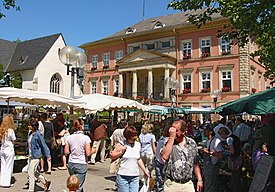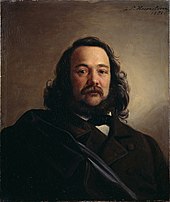Detmold
This article needs additional citations for verification. (April 2008) |
Detmold | |
|---|---|
 The princely castle. | |
Location of Detmold within Lippe district  | |
| Country | Germany |
| State | North Rhine-Westphalia |
| Admin. region | Detmold |
| District | Lippe |
| Subdivisions | 27 |
| Government | |
| • Mayor | Rainer Heller (SPD) |
| Area | |
| • Total | 129.39 km2 (49.96 sq mi) |
| Elevation | 134 m (440 ft) |
| Population (2023-12-31)[1] | |
| • Total | 74,835 |
| • Density | 580/km2 (1,500/sq mi) |
| Time zone | UTC+01:00 (CET) |
| • Summer (DST) | UTC+02:00 (CEST) |
| Postal codes | 32701–32760 |
| Dialling codes | 05231, 05232 |
| Vehicle registration | LIP |
| Website | www.detmold.de |
Detmold (German pronunciation: [ˈdɛtmɔlt]) is a city in North Rhine-Westphalia, Germany, with a population of about 73,400 (2013). It was the capital of the small Principality of Lippe from 1468 until 1918 and then of the Free State of Lippe until 1947. Today it is the administrative center of the district of Lippe and of the Regierungsbezirk Detmold. The Church of Lippe has its central administration located in Detmold. The Reformed Redeemer Church is the preaching venue of the state superintendent of the Lippe church.
History
Iron Age
About 5 kilometres (3 mi) to the southwest of Detmold is the Grotenburg hill with a prehistoric circular rampart and the Hermann monument (Template:Lang-de).[2] The monument commemorates the so-called Battle of the Teutoburg Forest, a battle in 9 AD which may or may not have been fought close to the present location of Detmold. In this encounter, Germanic tribes led by Hermann (Template:Lang-la) defeated Roman legions under the command of Publius Quinctilius Varus.[3]
Middle Ages
Detmold was first mentioned as Theotmalli in 783, the year of a battle between the Saxons and Charlemagne's forces nearby.[2][3] This was an event in the Saxon Wars. In 1005 a Tietmelli or Theotmalli region (Gau) is referred to in documents.
In 1263, Bernard III of Lippe fortified the settlement at the crossing of the trade route from Paderborn to Lemgo over the Werre River with stone walls and granted it a municipal charter. Its population was reported in 1305 as 305. Market rights granted in 1265 led to rapid economic development. Its defenses were greatly strengthened after severe damage had been inflicted on the town during the conflict with Soest in 1447. A major fire in 1547 destroyed more than 70 houses.

In 1550, Detmold became the permanent residence of Count Simon III of Lippe. The counts were elevated to princes in 1789, and Detmold remained the capital of the small Principality of Lippe until the end of the World War I in 1918, when all princely states in Germany were abolished. Today, Armin, Prince of Lippe is the owner of Detmold Castle.
Modern era
Street lighting was introduced in 1809, with oil-fired lanterns. By 1835, the town had become the most populous in Lippe, with over 4,000 residents. It grew to 12,000 in 1900 and over 30,000 in 1950.
From 1919 to 1947, Detmold was the capital of the Free State of Lippe. When Lippe was incorporated into the new German state of North Rhine-Westphalia, the town became the seat of the Lippe district, and since 1972 it has been the seat of the district administration of Lippe. With the administrative reform of 1970, 25 nearby villages were incorporated into the city.
Main sights

- Hochschule für Musik Detmold (Music Academy of Detmold)
- Hochschule Ostwestfalen-Lippe (Ostwestfalen-Lippe University of Applied Sciences)
- LWL-Freilichtmuseum Detmold (Detmold Open-air Museum)
- Lippisches Landesmuseum (Museum)
- Landestheater Detmold (Theater)
- Hermannsdenkmal (Arminius Monument)
- Externsteine
- Adlerwarte Berlebeck (Falconry)
- Fürstliches Residenzschloß, a Renaissance castle in the center of the town park.
- Donoper Teich (pond)
- Hasselbachteich (pond)
- Vogelpark Heiligenkirchen (bird sanctuary)


Culture
The town supports the Nordwestdeutsche Philharmonie for regular symphony concerts.
Twin towns — sister cities
Detmold is twinned with:
Notable people


Notable people born in Detmold include:
- Friedrich Adolf Lampe (1683–1729), theologian
- Simon August, Count of Lippe-Detmold (1727–1782), Count of Lippe
- Leopold I, Prince of Lippe (1767–1802), Prince of Lippe
- Leopold Zunz (1794-1886), scientist, founder of Reform Judaism
- Leopold II, Prince of Lippe (1796–1851), Prince of Lippe
- Christian Dietrich Grabbe (1801–1836),[5] alongside Georg Büchner the most important innovator of German-language drama in his time
- Ferdinand Freiligrath (1810–1876), poet and author[6]
- Leopold III, Prince of Lippe (1821–1875), Prince of Lippe
- Georg Weerth (1822–1856)[7]
- Gustav Wallis (1830-1878), botanist and South American traveler
- Joseph Plaut (1879–1966), actor, spieler, elocutionist, singer and regional poet
- Jürgen Stroop (1895–1952), German Nazi general of the SS, war criminal
- Werner Buchholz (born 1922), engineer, creator of the art word byte
- Manfred Fuhrmann (1925–2005), old philologist
- Hans-Ulrich Schmincke (born 1937), volcanologist
- Heinz Burt (1942–2000), British musician and member of The Tornados
- Hans Ottomeyer (born 1946), art historian, for 11 years curator of the German Historical Museum in Berlin
- Iris Berben (born 1950), actress
- Peter Lampe (born 1954), German theologian
- Detlef Grumbach (born 1955), journalist, journalist, author and publisher
- Frank-Walter Steinmeier (born 1956), foreign minister and chancellor candidate for the SPD[8]
- Manfred Ostermann (born 1958), German local politician (independent) and former Landrat of Soltau-Fallingbostel
- Andreas Voßkuhle (born 1963), jurist, president of the Bundesverfassungsgericht
- Ludger Beerbaum (born 1963), jumping rider
- Sebastian Faust (born 1965), actor
- Wotan Wilke Möhring (born 1967), actor
- Matthias Opdenhövel (born 1970), German television presenter and journalist
- Sven Montgomery (born 1976), Swiss-American cyclist
- Vera Ludwig (born 1978), German poetess
- Stefan Langemann (born 1990), footballer
Long-time residents of Detmold include:
- Albert Lortzing (1801–1851), composer
- Johannes Brahms (1833–1897), composer
- Heinrich Drake (1881–1970), politician
- Felix Fechenbach (1894–1933), journalist
- Thomas Quasthoff (born 1959), bass-baritone
Others:
- Detmold child a child mummy who got its name from this city.
Amongst the honorary citizens of Detmold, besides politicians are scientists and artists who have served in Detmold. The best-known are the builder of the Hermannsdenkmal, Ernst von Bandel (1871), Reich Chancellor, Otto von Bismarck (1895), and Reich President, Paul von Hindenburg (1917).
References
- ^ "Bevölkerung der Gemeinden Nordrhein-Westfalens am 31. Dezember 2023 – Fortschreibung des Bevölkerungsstandes auf Basis des Zensus vom 9. Mai 2011" (in German). Landesbetrieb Information und Technik NRW. Retrieved 2024-06-20.
- ^ a b Chisholm, Hugh, ed. (1911). . Encyclopædia Britannica (11th ed.). Cambridge University Press.
- ^ a b Ripley, George; Dana, Charles A., eds. (1879). . The American Cyclopædia.
- ^ "Savonlinnan ystävyyskaupungit". savonlinna.fi. Retrieved 26 April 2014.
- ^ The Rough Guide to Germany. Penguin. July 5, 2012. ISBN 9781409359265.
- ^ Gilman, D. C.; Peck, H. T.; Colby, F. M., eds. (1905). . New International Encyclopedia (1st ed.). New York: Dodd, Mead.
- ^ Friedrich Engels. Routledge. November 5, 2013. p. 253. ISBN 9781136629181.
- ^ Judy Dempsey (October 17, 2005), A promotion to cabinet for Schröder's top aide New York Times.


